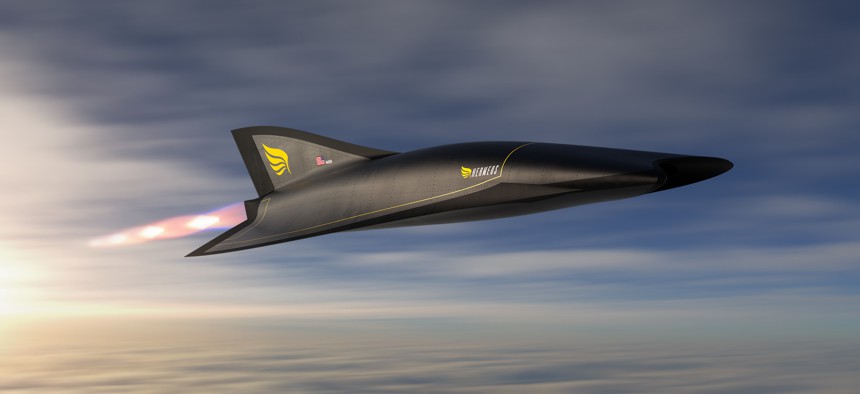
A concept image of the Hermeus Quarterhorse hypersonic aircraft. Hermeus
US Air Force, Venture Firms Make $60 Million Bet on Hypersonic Aircraft Startup
The deal calls for Georgia-based Hermeus to accelerate development of reusable test aircraft.
The U.S. Air Force, along with a number of venture capital funds, are making a $60 million bet on a Georgia-based startup, hoping the company’s efforts to develop a hypersonic airliner will benefit the military.
The service entered a $60 million strategic financing arrangement with Hermeus on July 30; the contract was announced Aug. 5. The deal is believed to be one of the largest such agreements brokered by AFWERX, the Air Force office that works to get commercial tech into the military. The Air Force did not respond to multiple questions about the deal.
“[H]ypersonic aircraft and propulsion systems are truly game-changing, and will revolutionize how we travel, just as automobiles did in the last century,” Maj. Gen. Heather Pringle, the Air Force Research Laboratory commander, said in a statement. “We are excited to be part of this effort, and to help propel this important technology.”
Hermeus is building a reusable hypersonic plane, something that has never been done before; so far, all hypersonic test vehicles and weapons have been built for a single flight.
The Air Force deal will allow Hermeus to accelerate its own work on technology that is projected to ultimately allow it to build a Mach-5 passenger aircraft that could fly from New York to London in 90 minutes. Executives said the company’s research and testing could speed up the Pentagon’s own quest for reusable hypersonic vehicles.
“It's really indicating the Air Force leaning in on not just investing in technology development, but it's really pushing for the ability to transition the capability to an operational system on the other end of it,” AJ Piplica, the company’s CEO and one of its founders, said in an interview.
The strategic financing arrangement also shows Hermeus’ desire to deepen its ties with the military. Last year, the Air Force gave the company a $1.5 million deal to explore how its commercial plane could be used to fly high-ranking government officials around the world. The Air Force did not disclose the specific venture firms or how much each contributed to the $60 million deal announced this week.
Founded in 2018 by four former Generation Orbit engineers, Hermeus plans to build three pilotless planes to prove out its technology. Called Quarterhorse, the test aircraft will be 40 feet long with a 10-foot wingspan.
The Air Force deal is enough money to get the Quarterhorse into test flights in about 18 months. The plan is to fly the test aircraft through 2023. The Air Force contract will allow the company to double the size of its staff to about 50 by the end of 2021 and speed up its test schedule by about one year.
“It's allowed us to really accelerate the pace at which we're able to scale the team [and] also allowed us to accelerate the vertical integration,” Piplica said. “Instead of constantly working with machine shops, now we're able to bring a lot more fab[rication] capability in-house earlier, and that helps us control a lot more of our schedule, costs, and more. It's really done quite a bit to accelerate the overall roadmap.”
The company has two goals for test flights: Fly at Mach 5—that’s five times faster than the speed of sound—and reuse the aircraft on multiple flights, said Michael Smayda, another Hermeus founder and its chief product officer. So far, all hypersonic test vehicles have only flown a single time.
“The purpose is to build an aircraft around our engine and test it across the full flight range,” said Skyler Shuford, a founder and chief operating officer.
The Quarterhorse will be powered by a General Electric J85 engine, the same power plant used in the T-38 trainer, and a high-speed, hypersonic engine being developed by Hermeus. The company’s hypersonic engine is essentially wrapped around the J85, Piplica said.
“Being able to marry the engine with the airframe sooner allows us to get to a fully integrated system faster,” said Smayda, a former SpaceX engineer.
The Quarterhorse “serves as a stepping stone to more intermediate products” before the company builds a larger passenger airliner,” Shuford said.
The Air Force contract sets a number of strategic objectives for Hermeus to meet within the next three years, to include building and testing three Quarterhorse aircraft.
“Getting to flight, that's the thing we need to do, because then there's nothing to argue with,” Smayda said.




